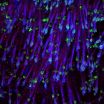Viral relics show cancer's 'footprint' on our evolution
2014-07-17
(Press-News.org) Viral relics show cancer’s ‘footprint’ on our evolution Cancer has left its ‘footprint’ on our evolution, according to a study which examined how the relics of ancient viruses are preserved in the genomes of 38 mammal species.
Viral relics are evidence of the ancient battles our genes have fought against infection. Occasionally the retroviruses that infect an animal get incorporated into that animal’s genome and sometimes these relics get passed down from generation to generation – termed ‘endogenous retroviruses’ (ERVs). Because ERVs may be copied to other parts of the genome they contribute to the risk of cancer-causing mutations.
Now a team from Oxford University, Plymouth University, and the University of Glasgow has identified 27,711 ERVs preserved in the genomes of 38 mammal species, including humans, over the last 10 million years. The team found that as animals increased in size they ‘edited out’ these potentially cancer-causing relics from their genomes so that mice have almost ten times as many ERVs as humans. The findings offer a clue as to why larger animals have a lower incidence of cancer than expected compared to smaller ones, and could help in the search for new anti-viral therapies.
A report of the research is published in the journal PLOS Pathogens.
‘We set out to find as many of these viral relics as we could in everything from shrews and humans to elephants and dolphins,’ said Dr Aris Katzourakis of Oxford University’s Department of Zoology, lead author of the report. ‘Viral relics are preserved in every cell of an animal: Because larger animals have many more cells they should have more of these endogenous retroviruses (ERVs) – and so be at greater risk of ERV-induced mutations – but we’ve found this isn’t the case. In fact larger animals have far fewer ERVs, so they must have found ways to remove them.’
A combination of mathematical modelling and genome research uncovered some striking differences between mammal genomes: mice (c.19 grams) have 3331 ERVs, humans (c.59 kilograms) have 348 ERVs, whilst dolphins (c.281 kilograms) have just 55 ERVs.
‘This is the first time that anyone has shown that having a large number of ERVs in your genome must be harmful – otherwise larger animals wouldn’t have evolved ways of limiting their numbers,’ said Dr Katzourakis. ‘Logically we think this is linked to the increased risk of ERV-based cancer-causing mutations and how mammals have evolved to combat this risk. So when we look at the pattern of ERV distribution across mammals it’s like looking at the ‘footprint’ cancer has left on our evolution.’
Dr Robert Belshaw of Plymouth University Peninsula Schools of Medicine and Dentistry, School of Biomedical and Healthcare Sciences, added: “Cancer is caused by errors occurring in cells as they divide, so bigger animals - with more cells - ought to suffer more from cancer. Put simply, the blue whale should not exist. However, larger animals are not more prone to cancer than smaller ones: this is known as Peto's Paradox (named after Sir Richard Peto, the scientist credited with first spotting this). A team of scientists at Oxford, Plymouth and Glasgow Universities had been studying endogenous retroviruses, viruses like HIV but which have become part of their host's genome and which in other animals can cause cancer. Surprisingly, they found that bigger mammals have fewer of these viruses in their genome. This suggests that similar mechanism might be involved in fighting both cancer and the spread of these viruses, and that these are better in bigger animals (like humans) than smaller ones (like laboratory mice).”
ERVs that are immediately harmful to an animal tend not be passed on, what makes them troublesome is that having arrived at one location in a genome the replication process means they can be copied across, ‘jumping’, to somewhere else. ERVs can, for example, ‘jump’ into the middle of gene machinery responsible for suppressing tumours, damaging it and ratcheting up the risk of mutations turning into cancer.
‘We know that some cancers, such as t-cell leukaemia, are directly linked to retroviruses but a lot of the time ERVs contribute to the number of things that need to go wrong in cells for cancers to arise,’ said Dr Katzourakis. ‘As animals get bigger so the number of cells increases and there are more opportunities for things to go wrong, so there is an evolutionary pressure for larger animals to reduce the number of ERVs.’
Dr Gkikas Magiorkinis of Oxford University’s Department of Zoology, an author of the report, said: ‘We know that taller people have higher risk for some cancers, which fits our study about ERVs posing evolutionary pressure through cancer. Yet we still have no evidence that ERVs might have causal links with cancer in humans, even though they clearly cause cancers in other animals such as mice. We need to search in a more systematic way to see if ERVs cause cancer in humans, and our study suggests that viral pathogenic mechanisms in larger animals like humans would be more complex than those observed in smaller animals.’
Dr Robert Belshaw of Plymouth University Peninsula Schools of Medicine and Dentistry, School of Biomedical and Healthcare Sciences, added: 'Cancer is caused by errors occurring in cells as they divide, so bigger animals - with more cells - ought to suffer more from cancer. Put simply, the blue whale should not exist. However, larger animals are not more prone to cancer than smaller ones: this is known as Peto's Paradox (named after Sir Richard Peto, the scientist credited with first spotting this). A team of scientists at Oxford, Plymouth and Glasgow Universities had been studying endogenous retroviruses, viruses like HIV but which have become part of their host's genome and which in other animals can cause cancer. Surprisingly, they found that bigger mammals have fewer of these viruses in their genome. This suggests that similar mechanism might be involved in fighting both cancer and the spread of these viruses, and that these are better in bigger animals (like humans) than smaller ones (like laboratory mice).'
The research suggests that larger creatures must have more effective anti-viral genes and resources than smaller ones and, if these can be identified, in the future it may be possible to mimic these mechanisms to produce new anti-viral therapies.
The new study is relevant to Peto’s Paradox, an observation made by Sir Richard Peto that the incidence of cancer does not appear to correlate with the number of cells in an organism. ‘Our work doesn’t solve Peto’s paradox as a whole but is has solved it in respect of infection,’ said Dr Katzourakis.
INFORMATION:
For more information contact Dr Aris Katzourakis on +44(0)1865 281847 mobile; +44 (0)7922 162006 or email aris.katzourakis@zoo.ox.ac.uk Alternatively contact the Oxford University News Office on +44 (0)1865 283877 or email news.office@admin.ox.ac.uk Notes to editors *A full report of the research, entitled ‘Larger Mammalian Body Size Leads to Lower retroviral Activity’, is published in PLOS Pathogens embargoed until 19:00 BST/14:00 US ET 17 July 2014.
*The work was supported by the Royal Society and the UK’s Medical Research Council (MRC).
ELSE PRESS RELEASES FROM THIS DATE:
When is a molecule a molecule?
2014-07-17
Using ultra-short X-ray flashes, an international team of researchers watched electrons jumping between the fragments of exploding molecules. The study reveals up to what distance a charge transfer between the two molecular fragments can occur, marking the limit of the molecular regime. The technique used can show the dynamics of charge transfer in a wide range of molecular systems, as the scientists around Dr. Benjamin Erk and Dr. Daniel Rolles of DESY and Professor Artem Rudenko of Kansas State University report in the scientific journal Science. Such mechanisms play ...
Pitt-led study suggests cystic fibrosis is 2 diseases, 1 doesn't affect lungs
2014-07-17
PITTSBURGH, July 17, 2014 – Cystic fibrosis (CF) could be considered two diseases, one that affects multiple organs including the lungs, and one that doesn't affect the lungs at all, according to a multicenter team led by researchers at the University of Pittsburgh School of Medicine. The research, published online today in PLOS Genetics, showed that nine variants in the gene associated with cystic fibrosis can lead to pancreatitis, sinusitis and male infertility, but leave the lungs unharmed.
People with CF inherit from each parent a severely mutated copy of a gene ...
Scientists find protein-building enzymes have metamorphosed & evolved new functions
2014-07-17
LA JOLLA, CA AND JUPITER, FL—Scientists at The Scripps Research Institute (TSRI) and Hong Kong University of Science and Technology (HKUST) and their collaborators have found that ancient enzymes, known for their fundamental role in translating genetic information into proteins, evolved myriad other functions in humans. The surprising discovery highlights an intriguing oddity of protein evolution as well as a potentially valuable new class of therapeutic proteins and therapeutic targets.
"These new protein variants represent a previously unrecognized layer of biology—the ...
A new stable and cost-cutting type of perovskite solar cell
2014-07-17
Perovskite solar cells show tremendous promise in propelling solar power into the marketplace. The cells use a hole-transportation layer, which promotes the efficient movement of electrical current after exposure to sunlight. However, manufacturing the hole-transportation organic materials is very costly and lack long term stability. Publishing in Science, a team of scientists in China, led by Professor Hongwei Han in cooperation with Professor Michael Grätzel at EPFL, have developed a perovskite solar cell that does not use a hole-transporting layer, with 12.8% conversion ...
Scientists complete chromosome-based draft of the wheat genome
2014-07-17
MANHATTAN, Kansas — Several Kansas State University researchers were essential in helping scientists assemble a draft of a genetic blueprint of bread wheat, also known as common wheat. The food plant is grown on more than 531 million acres around the world and produces nearly 700 million tons of food each year.
The International Wheat Genome Sequencing Consortium, which also includes faculty at Kansas State University, recently published a chromosome-based draft sequence of wheat's genetic code, which is called a genome. "A chromosome-based draft sequence of the hexaploid ...
Ultrafast X-ray laser sheds new light on fundamental ultrafast dynamics
2014-07-17
MANHATTAN, Kansas — Ultrafast X-ray laser research led by Kansas State University has provided scientists with a snapshot of a fundamental molecular phenomenon. The finding sheds new light on microscopic electron motion in molecules.
Artem Rudenko, assistant professor of physics and a member of the university's James R. Macdonald Laboratory; Daniel Rolles, currently a junior research group leader at Deutsches Elektronen-Synchrotron in Hamburg, Germany, who will be joining the university's physics department in January 2015; and an international group of collaborators ...
No evidence that California cellphone ban decreased accidents, says Colarado University Boulder researcher
2014-07-17
In a recent study, a researcher at the University of Colorado Boulder found no evidence that a California ban on using hand-held cellphones while driving decreased the number of traffic accidents in the state in the first six months following the ban.
The findings, published in the journal Transportation Research Part A: Policy and Practice, are surprising given prior research that suggests driving while using a cellphone is risky. For example, past laboratory studies have shown that people who talk on a cellphone while using driving simulators are as impaired as people ...
Peering into giant planets from in and out of this world
2014-07-17
Lawrence Livermore scientists for the first time have experimentally re-created the conditions that exist deep inside giant planets, such as Jupiter, Uranus and many of the planets recently discovered outside our solar system.
Researchers can now re-create and accurately measure material properties that control how these planets evolve over time, information essential for understanding how these massive objects form. This study focused on carbon, the fourth most abundant element in the cosmos (after hydrogen, helium and oxygen), which has an important role in many types ...
Help wanted: Principals who love change
2014-07-17
DALLAS (SMU) – Training principals for new roles is key to U.S. Department of Education school reforms, according to a new report by SMU researchers. But insufficient training and support for principals to meet the new expectations is leading to a leadership crisis. Twenty percent of newly minted principals leave the profession after two years and seasoned professionals are opting for early retirement.
Education researchers Lee Alvoid and Watt Lesley Black Jr. examine school districts at the forefront of supporting and training effective principals in their report "The ...
CNIO researchers discover a gene that links stem cells, aging and cancer
2014-07-17
An organism is healthy thanks to a good maintenance system: the normal functioning of organs and environmental exposure cause damage to tissues, which need to be continuously repaired. This process is not yet well understood, but it is known that stem cells in the organs play a key role, and that when repair fails, the organism ages more quickly. Researchers from the Spanish National Cancer Research Centre (CNIO) have "discovered one of the key genes that make up the maintenance mechanism for tissues" says Miguel Foronda, the first author of the manuscript.
The study ...


